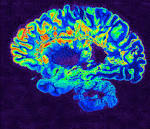Source: About Wessam Bou-Assaly
BRAIN MRI and Autism
Autism and Brain MRI
Wessam Bou-Assaly, MD
A national research network led by UNC School of Medicine’s Joseph Piven, MD, found
that many toddlers diagnosed with autism at two years of age had a substantially greater
amount of extra-axial cerebrospinal fluid (CSF) at six and 12 months of age, before
diagnosis is possible. They also found that the more CSF at six months — as measured
through MRIs — the more severe the autism symptoms were at two years of age.
Until the last decade, the scientific and medical communities viewed CSF as merely a
protective layer of fluid between the brain and skull, not necessarily important for
proper brain development and behavioral health. But scientists then discovered that
CSF acted as a crucial filtration system for byproducts of brain metabolism.
Every day, brain cells communicate with each other. These communications cause brain
cells to continuously secrete byproducts, such as inflammatory proteins that must be
filtered out several times a day. The CSF handles this, and then it is replenished with
fresh CSF four times a day in babies and adults.
The researchers found that increased CSF predicted with nearly 70 percent accuracy
which babies would later be diagnosed with autism. It is not a perfect predictor of autism, but the CSF differences are observable on a standard MRI. “
Wessam Bou-Assaly: Dementia
Different Types of Dementia
Wessam Bou-Assaly, MD
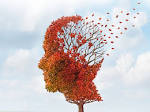
Alzheimer’s Disease
AD is a chronic neurodegenerative disease that usually has a progressive worsening course. It is characterized by loss of neurons and synapses in the cerebral cortex, resulting in gross atrophy of the affected regions, mainly the temporal and parietal lobes and parts of the frontal cortex and cingulate gyrus.
It is the cause of 60% to 70% of cases of dementia.
The most common early symptom is difficulty in remembering recent events ( short-memory loss). As the disease advances, symptoms can include problems in language, disorientation (including easily getting lost), mood swings, loss of motivation, not managing self care, and behavioral issues. The patients often withdraw from family and society.
Gradually, bodily functions are lost, ultimately leading to death.
Although the speed of progression can vary, the average life expectancy following diagnosis is three to nine years.
The cause of Alzheimer’s disease is poorly understood.. About 70% of the risk is believed to be genetic with many genes usually involved. Other risk factors include a history of head injury, depression or hypertension.
Frontotemporal dementia ( Pick’s Disease)
Frontotemporal dementia ( also known as Pick’s disease or frontotemporal lobar degeneration) primarily affect the frontal and/or temporal lobes of the brain and are generally associated with personality and behavior.
In frontotemporal dementia, portions of these lobes atrophy. Clinical features are early personality and behavioral changes ( Disinhibition, euphoria, apathy), Compulsive behaviors (peculiar eating, habits), executive disfunction and later appearance of memory deficits. The dramatic changes in the personality is associated with socially inappropriate, impulsive or emotionally blunted behaviors.
Frontotemporal dementia is often misdiagnosed as a psychiatric problem or as Alzheimer’s disease, but it tends to occur at a younger age than does Alzheimer’s disease, typically between the ages of 40 and 70, with a more delayed occurrence of memory problems.
Dementia with Lewy Bodies
Dementia with Lewy bodies (DLB) is one of the most common types of progressive dementia.
The central feature of DLB is progressive cognitive decline, combined with three additional defining features:
1- Visual hallucinations.
2- Fluctuations in alertness and attention, often leading to misdiagnose as delirium. ( frequent drowsiness, lethargy, lengthy periods of time spent staring into space, or disorganized speech;
3-Parkinsonian motor symptoms, such as rigidity and the loss of spontaneous movement.
People may also suffer from depression. The symptoms of DLB are caused by the build-up of Lewy bodies (alpha-synuclein protein) inside the nuclei of neurons in areas of the brain that control particular aspects of memory and motor control.
The similarity of symptoms between DLB and Parkinson’s disease, and between DLB and Alzheimer’s disease, can often make it difficult for a doctor to make a definitive diagnosis. In addition, Lewy bodies are often also found in the brains of people with Parkinson’s and Alzheimer’s diseases. These findings suggest that either DLB is related to these other causes of dementia or that an individual can have both diseases at the same time. DLB usually occurs sporadically, in people with no known family history of the disease. However, rare familial cases have occasionally been reported.
Normal Pressure Hydrocephalus
Normal pressure hydrocephalus (NPH) is a form of hydrocephalus( Dilated ventricles).
It can occur without a known cause, or it may be caused by any condition that blocks the flow of cerebrospinal fluid (CSF), resulting in increased volume of CSF in the ventricles.
Ataxia ( lack of voluntary coordination) and urinary incontinence appear early in the disease. The dementia symptoms of NPH can be similar to those of Alzheimer’s disease.
NPH can be reversed in many people with appropriate treatment. But first it must be correctly diagnosed. NPH is thought to account for about 5% of all dementias.
Vascular Dementia
Vascular dementia is an umbrella term that describes impairments in cognitive function caused by problems in the brain blood vessels. It accounts for 15-20 % of dementia cases and the risk increases dramatically with age.
Risk factors for cerebrovascular disease include hypertension, hyperlipidemia, smoking diabetes.
Usually there is stepwise decline in memory, with early executive dysfunction. Cerebral infarcts or white matter changes are seen on MRI.
Creutzfeldt-Jakob Disease or Prion disease
Creutzfeldt-Jakob disease (CJD) is a rare, degenerative, fatal brain disorder. It affects about one person in every one million people per year worldwide.
CJD usually appears in later life and runs a rapid course. Typically, onset of symptoms occurs about age 60, and about 90 percent of patients die within 1 year.
The disease is characterized by behavioral changes, rapidly progressive memory problems with myoclonus and seizures.
As the illness progresses, mental deterioration becomes pronounced and involuntary movements, blindness, weakness of extremities, and coma may occur.
Wernicke-Korsakoff Syndrome
Wernicke-Korsakoff syndrome is caused by a thiamine ( Vitamin B1) deficiency.
It involves damage to multiple nerves in both the central nervous system (brain and spinal cord) and the peripheral nervous system.
The cause is generally attributed to malnutrition, especially lack of vitamin B1 (thiamin), which is common in those with alcoholism. Heavy alcohol use interferes with the breakdown of thiamin in the body, so even if someone with alcoholism follows a well-balanced diet, most of the thiamin is not absorbed.
Wessam Bou-Assaly, MD is a Radiologist specialized in Neuroradiology and Head and Neck Imaging.
Wessam Bou-Assaly – How To Create Poetry
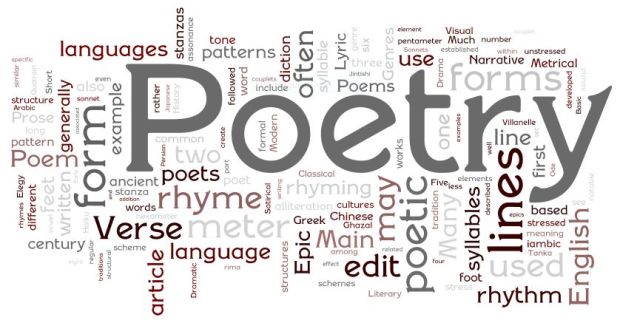 Wessam Bou-Assaly loves to read poetry, and enjoys talking about the subject whenever he can find someone who is equally enthusiastic about poems. Many people don’t realize that writing verses can be a liberating experience, even if someone is not especially talented.
Wessam Bou-Assaly loves to read poetry, and enjoys talking about the subject whenever he can find someone who is equally enthusiastic about poems. Many people don’t realize that writing verses can be a liberating experience, even if someone is not especially talented.
Finding Inspiration
Finding inspiration is crucial. We can call it a muse, or anything else, but it doesn’t have to be a person. It can be a place, or even an activity, something that evokes inspiration. Once it’s there, all you have to do is feed it and work on it.
Capture a Moment
Many enthusiasts make the mistake of trying to hit the ball out of the park, trying to write a very long poem with an intricate story. A moment can often be much more powerful, conveying all the emotions that you try to summon in a brief, spontaneous poem.
Create (or Steal) a Conversation
Talking to others is a big part of the human experience, one that most people could not live without. This is probably also the reason why we so often find these conversations fascinating and inspiring. Every interaction holds some potential when it comes to writing poetry. Listening to others can have a similar effect, so walk around with open ears.
Write Often
Writing poems will require just that, writing. There are many prominent writers out there who don’t believe in the phenomenon called writer’s block. Just starting the process – even if it doesn’t result into a poetical masterpiece – can make a difference.
Wessam Bou-Assaly loves to read poems and hopes that they will make a comeback in many people’s lives.
Sources:
http://www.writersdigest.com/editor-blogs/poetic-asides/advice/5-ways-how-to-write-a-poem
http://thewritepractice.com/enjoy-poetry/
Wessam Bou-Assaly – Are Handheld Devices the Future in Radiology?
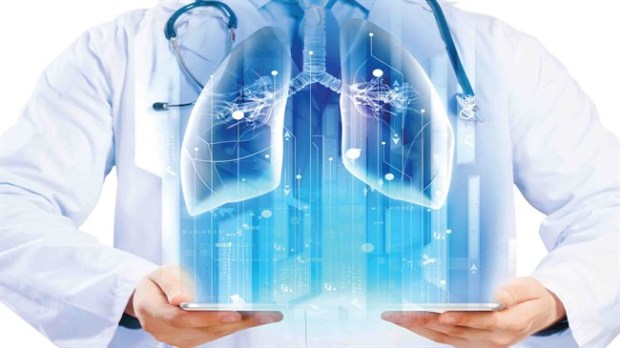 medical imaging technologies, the bigger and better machines are much more capable. Still, a future where small imaging devices would be commonplace is definitely a possibility.
medical imaging technologies, the bigger and better machines are much more capable. Still, a future where small imaging devices would be commonplace is definitely a possibility.
Possible Benefits
Easy access is one of the most obvious benefits that come to mind. If radiologists could use handheld imaging devices, they could also carry those devices with them and use them with greater ease whenever and wherever they are needed. Among the potential limiting factors, we have to mention costs and even confidentiality, as a device like that would likely be connected to the Internet, leaving it vulnerable to potential cyber-attacks.
Why They’re Still Not Feasible
Handheld devices could one day take over the field of radiology, but there are clear reasons why this revolution will not happen in the foreseeable future. There are actually some devices that can do CT brain imaging and even mammograms, but the quality of the imaging, combined with the clear limitations that the size of the screen brings, simply do not allow them to become anything more than an emergency solution.
For emergency purposes, such devices are viable and can actually help out physicians and other medical practitioners, but until the technology becomes more powerful and these devices become capable of providing a bigger image through either holographic or virtual reality solutions, traditional machines will remain the dominant form of radio imaging. Wessam Bou-Assaly is an expert radiologist who loves to see new technical innovations in his profession.
Sources: http://www.futuremedicine.com/doi/full/10.2217/iim.10.54
http://www.wsj.com/articles/virtual-reality-is-coming-to-medical-imaging-1455592257
Wessam Bou-Assaly on “The Championships”
 As an avid tennis fan who loves to follow the game as much as he likes to play it, Wessam Bou-Assaly appreciates the special sporting event that the Wimbledon Grand Slam is every year. When asked to pick the best, most prestigious one out of the four Grand Slams, most people usually mention Wimbledon, and they probably have very good – and valid – reasons to do that.
As an avid tennis fan who loves to follow the game as much as he likes to play it, Wessam Bou-Assaly appreciates the special sporting event that the Wimbledon Grand Slam is every year. When asked to pick the best, most prestigious one out of the four Grand Slams, most people usually mention Wimbledon, and they probably have very good – and valid – reasons to do that.
Prestige
For starters, Wimbledon is the oldest out of the four, having been founded in 1877, four years before the US Open. While its age is important, that’s not the only reason for this distinction. The other – and probably more important – is its status. Until the 1924/1925 season, Wimbledon was the only Grand Slam tournament. It was only that year when the other three tournaments (Australian Open, French Open, and US Open) have joined Wimbledon in the rankings, starting a new era in tennis.
Played on Grass
There is just something majestic about grass. Maybe it’s the fact that grass courts are – by far – the rarest out of all surfaces. There are not a whole lot of grass courts around the world, certainly not if we go by professional standards.
The Location
The fact that it is played in London, often in the courtesy of one or more members of the royal family, doesn’t hurt its case either. Even the Queen has attended the tournament in recent years, several decades after her previous visit which took place in 1977. As a big fan of the game, Wessam Bou-Assaly appreciates the role that Wimbledon plays in the tennis world.
Sources:
http://www.totalsportek.com/list/nine-facts-make-wimbledon-different-grand-slams/
Wessam Bou-Assaly on Learning to Play the Piano
 Wessam Bou-Assaly is an avid enthusiast of classical music who enjoys playing the piano whenever he can get the chance to do so. Piano is a popular musical instrument because it offers people a glimpse into what it would be like if they could really play it. But what does it take to get to an at least intermediate level?
Wessam Bou-Assaly is an avid enthusiast of classical music who enjoys playing the piano whenever he can get the chance to do so. Piano is a popular musical instrument because it offers people a glimpse into what it would be like if they could really play it. But what does it take to get to an at least intermediate level?
Ease Your Way Into it
The ability to play fast requires an enormous amount of skill. In the beginning, playing at a slower but more concentrated pace can really help in memorizing patterns and learning different tunes. Speed cannot really be forced. It will come on its own when your skill level is high enough and the muscle memory kicks in.
Full Concentration
Daniel Barenboim, one of the best piano players in the world, often mentions concentration. Not just any kind either, but the type that requires all of your willpower. Half an hour of spirited, concentrated effort can prove to be more valuable than five hours of procrastination interrupted by occasional surges of creativity. Practice does not require anyone’s genius, only their maximum effort.
Master Short Passages
Mastering the piano is not about learning songs. Just because you can play a song at a high level – or even perfectly – doesn’t mean you can play the piano. Short passages are good because they engage your brain, allowing it to absorb the knowledge more efficiently, building muscle memory in the process.
Wessam Bou-Assaly has managed to master the piano at an intermediate level.
Sources:
Meditation and Brain Structure
Effect of Meditation on the Brain
Wessam Bou-Assaly, MD
The effect of the meditation on the brain has been a subject of many researches recently. Meditation appears to have an amazing neurological benefits, suspected from ancient times, just now being confirmed by MRI, functional MRI and EEG.
Most recently, a study conducted by a Harvard affiliated team out of Massachusetts General Hospital (MGH), concluded that meditation has tangible effects, confirmed by MRI, on the human brain structure. An 8 week program of mindfulness meditation studied by MRI scans, showed for the first time clear evidence that meditation produces “massive changes” in brain Gray Matter.
MRI scans documented for the first time how meditation produces massive changes inside the brain’s gray matter. The structural differences between the brains of experienced meditation practitioners and individuals with no history of meditation, showed thickening of the cerebral cortex in areas associated with attention and emotional integration.
Meditation also appears to help preserve the aging brain. A study from UCLA found that long-term meditators had better-preserved brains than non-meditators as they aged. Participants who’d been meditating for an average of 20 years had more grey matter volume throughout the brain.
A Yale University interesting studies in the last few years, found that mindfulness meditation also decreases activity in the default mode network (DMN), the brain network responsible for mind-wandering and self-referential thoughts – a.k.a., “monkey mind.” The DMN is active when we’re not thinking about anything in particular, wandering from thought to thought. Since mind-wandering is typically associated with being less happy, ruminating, and worrying about the past and future, it’s the goal for many people to dial it down. Several studies have shown that meditation, though its quieting effect on the DMN, appears to do just this.
A Johns Hopkins study looked at the relationship between Mindfulness Meditation and its effect on depression, anxiety, and pain. Researcher Madhav Goyal and his team found that the effect size of meditation was moderate, at 0.3 but equal to the effect size for antidepressants which is also 0.3, which makes the effect of Meditation sound pretty good, making the Meditation an active form of brain training.
Meditation has central effects on improving attention and concentration, reduces anxiety, especially social anxiety, can be very effective in helping people recover from various types of addiction, including quitting smoking and can help kids in school performance.
Wessam Bou-Assaly, MD is a Radiologist in Ann Arbor, Michigan.
Wessam Bou-Assaly – A Brief Description of Tennis
Wessam Bou-Assaly is a radiologist located in Ann Arbor, Michigan. He worked for the Ann Arbor VA Hospital for seven years and he was an Assistant Professor of Radiology for six years. When he is not working or conducting research, he enjoys playing tennis. Tennis is a great way to relax and get a great workout. Tennis is a popular sport that requires agility, stamina and hand to eye coordination.
Tennis takes place on a rectangular court. It can either be played one on one or two on two. One player, or one team, stands on each side of a net. Each player has a tennis racket. The goal of the game is for one player to hit the ball to his or her opponent in a way that the opponent is unable to hit the ball back within the court. A player can earn a point by hitting the ball in a way that prevents the opponent from returning the ball to the opposite side of the court. The players use a hollow, felt covered ball, which bounces across the court. The winner is the player who earns the most points during the game.
Tennis is a recreational sport as well as an Olympic sport. It is played in countries all over the world. Bou-Assaly is a hard working radiologist and academic in Ann Arbor, Michigan. Wessam Bou-Assaly enjoys playing tennis when he is not researching or working. He enjoys getting a great workout and having fun on the tennis court.
Wessam Bou-Assaly, MD : The Risk of X-Ray
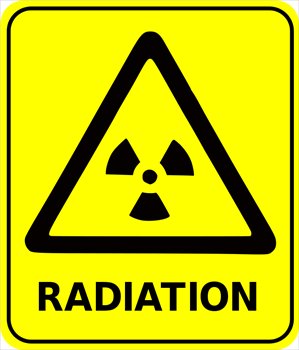 The Risk of X-rays
The Risk of X-rays
X-rays are produced when charged particles (electrons or ions) of sufficient energy hit a material and are suddenly decelerated upon their collision.
X-ray images are produced when a patient is placed in front of an X-ray detector and is then illuminated by short X-ray pulses. X-rays are absorbed by dense material with high atomic number such as bones, which are rich with calcium, and appear white on the resulting image. In the other hand, material with low or no atomic number, such as air in lungs, show up as dark patches on X-ray images because of their low absorption rates.
Type of X-Ray:
There are mainly 3 types of clinically used X-ray:
Radiography is the most familiar type of X-ray imaging. It is used to image mainly bones and the chest. Radiography also uses the smallest amounts of radiation.
Fluoroscopy is continuous live use of X-ray, and cane considered as a movie equivalent. The radiologist can watch the X-ray of the patient moving in real-time to watch the activity of the gut after a barium meal or intravascular contrast. Fluoroscopy uses more X-ray radiation than a standard X-ray, but the amounts are still tiny.
During Computed tomography (CT), the patient lies on a table and enters a ring-shaped scanner. A fan-shaped beam of X-rays passes through the patient into detectors placed across the patient’s body. The patient moves slowly into the machine so that a series of slices can be taken. This procedure uses the highest dose of X-rays because so many images are taken in one sitting.
The risk of X-Ray:
X-rays can cause mutations in the patient’s DNA and, therefore, might lead to cancer later in life. For this reason, X-rays are classified as a carcinogen by both the World Health Organization (WHO) and the US government. However, the benefits of X-ray technology far outweigh the potential negative consequences of using them. It is estimated that 0.4% of cancers in America are caused by CT scans and this level is expected to rise in parallel with the increased usage of CT scans in medical procedures.
Each procedure has a different risk associated with it, depending on the type of X-ray and the part of the body being imaged. In example:
- Chest X-ray is equivalent to 2.4 days of natural background radiation
- Lumbar spine is equivalent to 182 days of natural background radiation
- Upper gastrointestinal barium exam is equivalent to 2 years of natural background radiation
- CT head is equivalent to 243 days of natural background radiation
- CT abdomen is equivalent to 2.7 years of natural background radiation.
Even though the X-ray has been associated with risk of cancer, their benefit if used properly surpass their claimed danger: the importance of making the right diagnosis and choosing the correct course of treatment makes X-rays far more beneficial than they are dangerous.
Whether there is a small risk or no risk at all, the X-rays are here to stay.
Wessam Bou-Assaly, MD is a highly experienced radiologist in Ann Arbor -Michigan with long year of practice.
